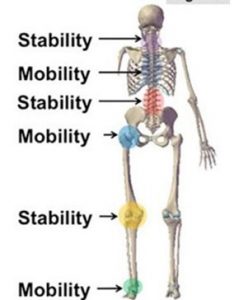Joint mobility and stability are components of human movement which are critical to prolonging pain free movement and preventing injury. However, they are often overlooked by those who focus on the traditional aspects of resistance training – increasing muscle mass and developing strength. The body relies on a combination of stable and mobile joints to maintain postural control through various movements and allow suitable energy transfer through the kinetic chain. If one these links in the chain (joints) is compromised, energy transfer is less efficient, and the chain could break (injury) if not addressed early.
Joint stability refers to the ability to maintain / control joint movement or position through various ranges of motion. Stability is achieved through increased strength from muscles and connective tissues around the joint and is critical for minimising injury and maximising postural control.
Conversely, mobility refers to how far a joint can move in certain directions before being restricted by tension from surrounding muscular and connective tissues. Therefore, stability and mobility go hand-in-hand in optimising movement patterns. Joints need sufficient mobility so that ideal movement patterns can be achieved which can help limit injury risk. For example, poor mobility through the ankles, impacts how deep you can squat, impacting on stability through the knee joint. Before long its likely to cause an injury.
Interestingly, joints that need to be stable alternate in series with joints that need to be mobile when viewed in the sequence of the kinetic chain (The attached image is a great visual of this concept). This makes joint stability and mobility highly important for athletes, as being able to transfer energy efficiently and safely through the kinetic chain is essential for most sports.
If some joints are unstable, or have limited mobility, it can put undue stress on areas of the body not prepared for such loads and can cause injury. Think of a golfer, mobility is a big part of the golf swing. Let’s say the shoulder aren’t mobile enough, its common to see the wrist or the back to become overactive and shift into compromising positions causing pain or even injury after repeated efforts.
Don’t overlook mobility or stability to focus on the more ‘attractive’ aspects of resistance training. By developing rock-solid fundamentals, your body will be more robust and harder to break! Practice stretching and proprioception to begin your mobility and stability development.




